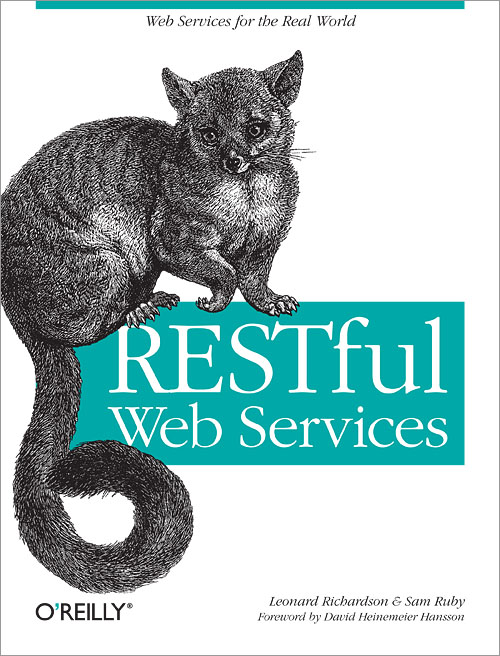REST
in theory
by Alex Muntada / @alexmuntada
What makes Internet a success?
World Wide Web
What makes the Web a success?
- easy
- customized
- linked
- pervasive
Timeline
Architectural Styles and the Design of Network-based Software Architectures
Roy Fielding (2000)
SOAP 1.2
W3C recommendation (2003)
RESTful Web Services
Leonard Richardson, Sam Ruby (2007)

REST becomes a success



RESTful Web APIs
Leonard Richardson, Mike Amundsen, Sam Ruby (2013)

REST(ful)
“Representational state transfer (REST) is a software architectural style consisting of a coordinated set of architectural constraints applied to components, connectors, and data elements, within a distributed hypermedia system.”
Architectural Properties of the Web
- Low Entry-Barrier (easy)
- Extensibility (customized)
- Distributed Hypermedia (linked)
- Internet-Scale (pervasive)
Interface Constraints
- Identification of Resources (URIs)
- Manipulation of Resources Through Representations
- Self-Descriptive Messages (stateless)
- The Hypermedia Constraint (HATEOAS)
HATEOAS
“Hypermedia as the engine of application state.”
- All application state is kept on the client side.
- The client can only change it through HTTP requests and responses.
- The client can find next actions through hypermedia controls.
- Hypermedia controls drive changes in application state.
Architectural Constraints
- Client-Server (one to one)
- Statelessness (application state, resource state)
- Caching (if-modified-since, if-match, 304)
- Uniform Interface
- Layered System (proxies, gateways)
- Code on Demand (javascript)
APIs



What is your worst nightmare in APIs?
Documentation
Bad, old, wrong or lack thereof.
Twitter REST API v1.1
POST statuses/update
- Resource URL: https://api.twitter.com/1.1/statuses/update.json
- HTTP Methods: POST
- Response Formats: json
- Parameters: status (required), in_reply_to_status_id, lat, long, place_id, display_coordinates, trim_user
What is missing in this example?
POST /1.1/statuses/update.json HTTP/1.1
User-Agent: curl/7.35.0
Host: api.twitter.com
Accept: */*
Content-Length: 68
Content-Type: application/x-www-form-urlencoded
status=Maybe%20he%27ll%20finally%20find%20his%20keys.%20%23peterfalk
HTTP/1.1 400 Bad Request
content-length: 61
content-type: application/json; charset=utf-8
date: Sun, 18 May 2014 19:30:43 UTC
server: tfe
set-cookie: guest_id=v1%3A140044144371735781; Domain=.twitter.com; Path=/; Expires=Tue, 17-May-2016 19:30:43 UTC
strict-transport-security: max-age=631138519
x-tfe-logging-request-category: API
{"errors":[{"message":"Bad Authentication data","code":215}]}
How can I fix it?
POST /1.1/statuses/update.json HTTP/1.1
User-Agent: curl/7.35.0
Host: api.twitter.com
Accept: */*
Content-Length: 68
Content-Type: application/x-www-form-urlencoded
Authorization:
OAuth oauth_consumer_key="xvz1evFS4wEEPTGEFPHBog",
oauth_nonce="kYjzVBB8Y0ZFabxSWbWovY3uYSQ2pTgmZeNu2VS4cg",
oauth_signature="tnnArxj06cWHq44gCs1OSKk%2FjLY%3D",
oauth_signature_method="HMAC-SHA1",
oauth_timestamp="1318622958",
oauth_token="370773112-GmHxMAgYyLbNEtIKZeRNFsMKPR9EyMZeS9weJAEb",
oauth_version="1.0"
status=Maybe%20he%27ll%20finally%20find%20his%20keys.%20%23peterfalk
How did I find that?
Read several pages of documentation:
The Semantic Gap
“The gap between the structure of a document and its real-world meaning—its application semantics. Media types, machine-readable profiles, and human-readable documentation bridge the semantic gap in different ways, but bridging the gap always requires the intervention of a human being at some point.”
RESTful Web APIs, p. 360
Final Thoughts
- Try to use less documentation and more hypermedia.
- Use existing standards, content types, link relations, etc.
- Propose new ones when there are none.
- Think about Internet-scale APIs.
- Let your APIs socialize with other APIs.
- Embrace the semantic challenge!
Questions?
by Alex Muntada / @alexmuntada